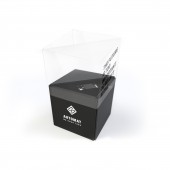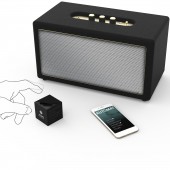DESIGN NAME:
Automat Toolkit Packaging
PRIMARY FUNCTION:
Packaging
INSPIRATION:
The Automat Packaging is inspired by a Japanese secret box. The Automat Packaging magically folds out like a staircase with each component elegantly displayed on one level each. The staircase becomes a pedagogical way of presenting the parts according to the levels of complexity. The dice shape makes the calibration of the sensors easy since you can relate to the different faces of the dice. The black color refers to the black box. It is within the black box the magic happens.
UNIQUE PROPERTIES / PROJECT DESCRIPTION:
The Automat Toolkit is a sensor kit that aids developers to quickly prototype IoT concepts. The Automat packaging allows you to go from concept to testing in no time. The packaging is a shell for prototyping and with a preprogrammed get-started exercise you get to play and understand the potential of the toolkit while calibrating the sensors at the same time. The Automat packaging lowers the threshold to get started with your own ideas and makes it quicker and easier to validate them.
OPERATION / FLOW / INTERACTION:
The packaging is a tool for prototyping. The below scenario illustrates how the user gets the product, connects the pieces and calibrates the sensors by playing with the potential of the system!
1. INTRO
A hidden message appears once you take the protective hood off. An encouragement to explore!
2. GET STARTED
Connect your kit to the Automat app and pick one pre-programmed sequence to explore the potential with your kit.
3. EXPLORE
Your Automat kit and packaging becomes a physical extension of the Spotify app where you can swap songs, pause or flip to the next song by interacting with it. Time to start thinking of what you could create yourself!
4. CALIBRATE
While you explore the system you also calibrate the sensors in your kit. A quite boring exercise in normal cases but here it becomes a part of understanding the potential!
PROJECT DURATION AND LOCATION:
Stockholm
FITS BEST INTO CATEGORY:
Packaging Design
|
PRODUCTION / REALIZATION TECHNOLOGY:
To realize the packaging a tool was made to cut the cardboard. The folding of the packaging shell and drawers as well as mounting them was made by hand by skilled craftsmen. We used screen printing for the graphics along with debossed details.
We are using three materials for the packaging. For the main body, we use a matte black, 2mm recycled cardboard with a black core. For the drawers a slightly thinner cardboard in 1mm. We kept the edges raw to add to the feeling that this is a prototyping kit. The second material we use for the interior inserts of the drawers. The EVA foam (100% recyclable of all production waste) drawer inserts is made up of three layers. Depending on the depth on the components it should hold we either die cut 1 or 2 layers to make sure all components always were presented at the surface of the drawer. The last material we use is for the transparent hood. It is made of PET plastic (100% post-consumer recycled plastic). The hood is made durable since it is designed to be used repeatedly over time.
SPECIFICATIONS / TECHNICAL PROPERTIES:
50mm (w) x 50mm (d) x 50mm (d)
TAGS:
IoT, packaging, unboxing, user experience
RESEARCH ABSTRACT:
The first we had to do was to understand the target group and who we were designing for. Who was the Automat developers kit aimed at and how could we attract them? Neue Labs developed the Automat as an alternative to bulkier developer kits such as Arduino. The Automat kit aims to give their users the possibility to design and prototype wearable IoT ideas in a quick way without having a big black box attached to it. It is simply not trustworthy to have a big box attached to the arm when you are designing a small wristband wearable for example. Even if your idea is in an early stage it should look good and of course work when you present it to decision makers, colleagues or clients. After initial discussions with the client, it became clear that their focus was to target developers close to or in the fashion industry. Our client had worked with the audience for a while and also hosted workshops in IoT in fashion before they created the Automat Toolkit. They knew the target group and they knew what the biggest issues were. The biggest fear was that the product would fail due to the fact that people got too intimidated to even get started. It was when we discussed this the idea was born that the actual packaging could support a getting started exercise. The key research question became – How could we lower threshold to actually try it out with the support of the packaging?
During the concept phase, we investigated different get started ideas and the user interaction steps for each idea. We ended up having a preprogrammed sequence when the user connected the device to the phone and the APP and explored the system by controlling Spotify. An app that many are familiar with. When the user controlled Spotify they would in the process also do all the boring stuff without focusing on them. Boring stuff being things like registering the kit online and calibrating the sensors. The user would rather focus on how easy and quick the kit could get up and running and get inspired to start working on their own sequences. When we had the first prototype of the packaging it became clear that the packaging was more than the getting started exercise. It was a shell for prototyping that could be used over and over again.
CHALLENGE:
There were two bigger creative challenges to this packaging design.
First off was the complexity of the packaging construction and the second challenge was the order quantity. When it comes to realizing designs these two are always tightly connected. The original construction wasn’t possible to automate due to the low order quantity (2000 pieces) so we had to look for other options. We needed to find a supplier that was willing to take on the order and they needed to have the required skills to make this by hand and still meet the price target set by our client. After a few weeks of intense hunting and sample reviews, we finally managed to find a supplier that was working with eco-friendly materials as well as had the craftsmen skills we so badly needed. We were able to solve this issue by the fact that we are close to the production in China and to the client in Sweden. We could with joint forces of the Boris offices in Hong Kong and Stockholm help the client find a match and facilitate a smooth sampling process by having us close to the production site and the client both at the same time.
ADDED DATE:
2018-11-30 11:47:17
TEAM MEMBERS (2) :
Boris Design Studio Team and Neue Labs Team
IMAGE CREDITS:
Boris Design Studio
PATENTS/COPYRIGHTS:
Copyright 2018 Neue Labs.
|










